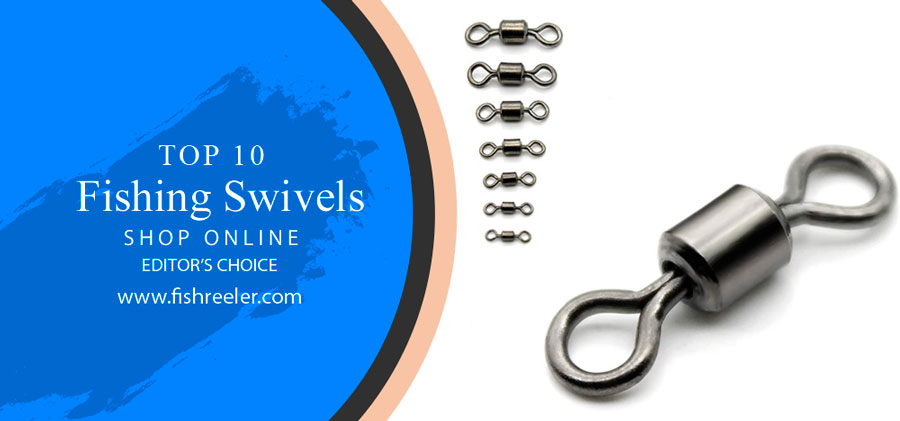
🎣 Get the Perfect Twist Every Time with Fishing Swivels! 🎣
Let’s face it, dealing with twisted and tangled lines can be frustrating and time-consuming. That’s why you definitely need fishing swivels in your tackle box.
🌟 Why Fishing Swivels are a Game-Changer: 🌟
✅ Prevent Line Twists and Tangles: The primary function of a fishing swivel is to allow the line to twist freely, preventing it from getting twisted and tangled.
✅ Easy to Use: Fishing swivels are incredibly easy to attach. Just tie your line on one end and attach your lure or hook on the other.
✅ Versatility: Suitable for all types of fishing, whether you are in fresh or saltwater, fishing from a boat, a pier, or the shore.
✅ Strength: Our swivels are strong and durable, ensuring that you don’t lose your catch due to a broken swivel.
✅ Smooth Casting: Swivels ensure a smooth and straight line cast, increasing your chances of catching fish.
🔶 Our fishing swivels are not just any swivels. We offer a range of sizes and styles to suit all your fishing needs. Expertly designed and rigorously tested, our swivels are made with the highest quality materials to ensure strength, durability, and smooth movement.
Master the Art of Fishing with Professional-Grade Swivels
Every angler knows the importance of high-quality gear; from the fishing rod to the line, every element plays a crucial role in determining the success of a fishing trip. One essential item that often gets overlooked is the fishing swivel. 🎣
A fishing swivel is a small device that consists of two rings connected by a pivoting joint. It is attached between the fishing line and the bait, allowing the bait to spin around without twisting the fishing line. It might seem insignificant compared to other fishing gear, but this small device can significantly enhance your fishing experience. 🔄
🔶 Understanding the nuances of fishing swivels and their correct usage can drastically enhance your fishing experience by preventing line twists, making it easier to swap out lures, and providing a stronger connection between your line and bait. 🚀
What are Fishing Swivels and Why You Need Them
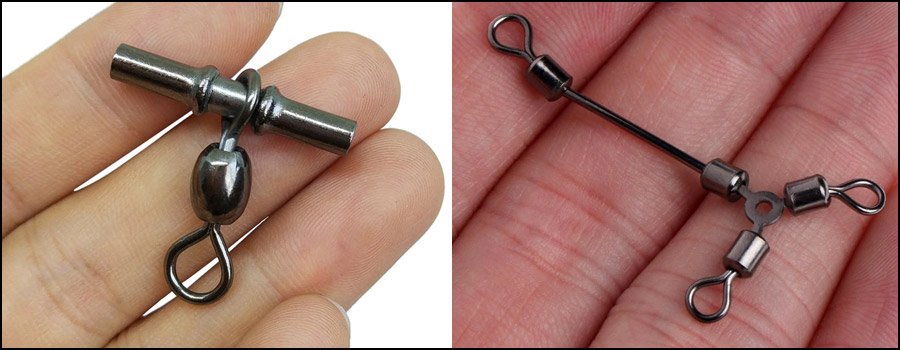
Description of Fishing Swivels
Fishing swivels are small yet essential devices used in fishing to connect the main line to the leader line or hook. A basic fishing swivel consists of two rings connected by a pivoting joint, which allows the connected parts to rotate independently of each other. This simple design serves multiple purposes, from preventing line twists to making it easier to change lures or hooks.🔄
Different Types of Swivels and Their Specific Uses
There are several types of fishing swivels, each designed for specific fishing situations:
🔲 Ball Bearing Swivel: This is the most popular and widely used type of swivel. It has a ball bearing inside, which allows for smooth rotation even under pressure, making it ideal for trolling or fishing with spinning lures.
🔲 Barrel Swivel: A simple design consisting of two rings connected by a barrel-shaped center. It is best suited for light to medium fishing applications.
🔲 Three-Way Swivel: This swivel has three rings connected to a central pivot, allowing you to connect your main line, leader, and a weight, all at the same time. It is perfect for bottom fishing or when you want to present your bait at a specific depth.
🔲 Snap Swivel: This swivel comes with a snap attached to one end, making it easier to change lures or hooks without having to retie your line. It is great for anglers who like to switch baits frequently.
🔲 Specialty Swivels: There are also several specialty swivels available in the market, like the slider swivel or the offshore swivel, designed for specific fishing applications like surfcasting or deep-sea fishing.
The Problem with Line Twist and How Swivels Help
Line twist is a common problem that anglers face, especially when using spinning reels or trolling. When the bait or lure spins in the water, it can cause the fishing line to twist, leading to tangles and knots. Over time, this can weaken the line and lead to a decreased casting distance and accuracy. 😓
Fishing swivels help prevent line twist by allowing the bait or lure to spin freely without affecting the line. As the swivel can rotate 360 degrees, it absorbs the twist that would otherwise be transferred to the fishing line. This ensures that your line remains straight and strong, enhancing your overall fishing experience. 💪
Top 10 Best Fishing Swivels – Editor’s Choice

Usually, fishing is associated with something pleasant and fascinating. But it becomes a real nightmare when your fishing line is twisted. You spend a lot of time and effort to eliminate twisting. And if the turn becomes commonplace, then soon you will have to throw out your fishing line, because twisting reduces the strength of the fishing line, the casting distance, and leads to its wear faster.
How to avoid this? With a swivel. This small, but very effective tool will help you forget about the problems with twisting the line. If you haven’t yet decided on the model that you need – right now we will tell you about the 10 best swivels hooks available on the market now!
#1 General Bearing Solid Swivels
These swivels are simply designed for extreme fishing situations that you can fall into. Therefore, we put them in the first place. They perfectly protect the fishing line from tangling and twisting and are very durable. A smooth rotating bearing is built into their bodies, and the material of the swivel is a durable metal suitable for fishing in any water. In one package you get as many as 100 pieces of such swivels, which are very strong and durable. They are designed for loads up to 28 kg or 61.7 pounds, which is a big indicator. Also, they have a not so long length – only 28 mm.
#2 Toasis Crossline 3-Way Fishing Swivels
Regardless of whether you fish in freshwater or salt, this swivel does not care. It excels in all conditions and is protected against corrosion. In addition, it is made of copper alloy and weighs very small. But this does not affect its ability to withstand catastrophically high loads – up to 176 pounds per 1 swivel. For greater convenience, the design of the swivels is equipped with 3 rings, with which you can tie the line.
#3 Dr. Fish Ball Bearing Stainless Swivels
The design of these swivels is made of durable stainless steel, so you can use them even in salt-water without worrying about rust. The kit includes 20 swivels with 11 different sizes. You can choose any one suitable for you. Soft and smooth stainless steel bearings are integrated into the housing, providing maximum protection against twisting. No matter what style of fishing you play, these swivels are perfect for any of them.
#4 Shaddock Fishing Ball Bearings Fishing Swivels
If the previous swivel was made entirely of stainless steel, then a combined alloy is used here. The body is made of copper, and the welding ring is made of steel. This allows you to minimize weight and strengthen the weakest areas at the same time. The bearings are also made of stainless steel, they rotate very smoothly and easily. They provide your line with maximum protection against twisting and abrasion. In addition, the swivels are corrosion resistant, which allows you to fish in saltwater too. And impact resistance and material quality will allow you to use these swivels for a long time.
#5 Riptail Three Way Cross-Line Barrel Swivels
Two rings are good, but 3 is better. But in addition to durable rings, the manufacturer equipped these swivels with excellent characteristics. The material is high-strength steel, resistant to any hit and abrasion. In addition, the swivels are treated with a black anti-corrosion coating. You can choose from 5 sizes and packaging from 5 to 50 pieces. The durability of these swivels varies depending on size from 30 to 250 pounds. This is a pretty good indicator for steel swivels. In any water and any type of fishing, this model will save your line from abrasion and twisting.
#6 Dr.Fish Assortment Three-Way Swivels Triple Swivels Trolling Catfish Rig
In addition to the three rings at the edges, these swivels are also equipped with a durable ring in the middle. The whole body is made of metal steel, which is resistant to corrosion. You can choose from 6 sizes with a resistance of 28 to 220 pounds. The design of the swivels allows you to effectively reel the fishing line on them. If the line breaks on one ring, you can further strengthen it on the others. Also, due to the strength of the structure, even with strong jig swivels will stand. The disadvantages are smaller sizes than in the photo. Also, a couple of pieces in the package came to be defective.
#7 Jasmine Ball Bearing Fishing Swivels
These are some of the most versatile swivels on this list. Because, depending on your preferences, you can choose from 9 different sizes. Here, every angler will find something for himself. In addition, swivels have excellent material quality. A copper case with a stainless steel welding ring will serve you for many years and will not let rust on the body. In addition to corrosion resistance, swivels have excellent impact resistance and abrasion resistance. A durable and smooth bearing inside will not allow your fishing line to tear at the most unnecessary moment.
#8 Shaddock Fishing Rolling Barrel Fishing Swivels
The rotating swivels from the Barrel will help you to prevent twisting and breaking of the line, regardless of the conditions in which you fish. Even when catching large heads from 30+ pounds, these swivels will work just fine. Thanks to the robust stainless steel construction, these swivels are gigantic. The nickel finish on them allows the fish to focus on the bait rather than on them. In addition, they have a smooth rotating mechanism. Available in 11 pack sizes of 50 or 100 pieces.
#9 Scotank Ball Bearing Stainless Steel Swivels
Thanks to 6 high-quality ball bearings, these fishing swivels are able to rotate 360 ° fast and smoothly. The material from which they are made is a mixture of copper and high-quality stainless steel, which allows you to lighten weight and increase strength. Welded rings at the end perfectly prevent twisting and breaking of the line during fishing. The smooth, streamlined shape reduces air and water resistance. This means that the installation of a swivel practically does not reduce the cast distance. With these swivels, you are guaranteed maximum performance when catching both small and fighting fish.
#10 Amysports Ball Bearing Swivels
The most lightweight, high-quality, and durable swivels made from 100% copper. 3 ball bearings inside will provide you very smooth and pleasant rotations. Also, thanks to the design of swivels, your line will be reliably protected from twisting and tearing. These swivels have great traction – from 33 to 507 pounds, which is a pretty big indicator. Although they are made of copper, they have a corrosion-resistant coating, so you can fish with them in both salt and freshwater. This is a strong and durable fishing tool that will last you many months.
How to Choose the Right Swivel
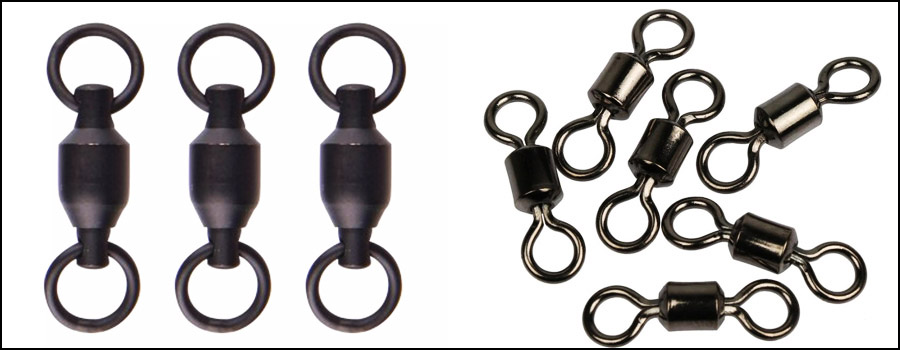
Selecting the right swivel is crucial for a successful fishing adventure. There are several factors to consider when choosing the right swivel for your fishing setup:
Factors to Consider: Fishing Style, Target Species, Water Conditions
🧿 Fishing Style: The type of fishing you plan to do will significantly influence your choice of swivel. For example, if you are trolling, a ball bearing swivel is ideal as it provides smooth rotation even under pressure. If you plan to change lures frequently, a snap swivel will be more convenient.
🧿 Target Species: The size and strength of the fish you are targeting will also impact your choice of swivel. Larger and stronger fish will require a more robust and durable swivel.
🧿 Water Conditions: Consider the water clarity and current when selecting a swivel. In clear water, a smaller, less visible swivel may be more effective. In strong currents, a heavier swivel may be required to keep your bait at the desired depth.
The Importance of Swivel Size and Strength
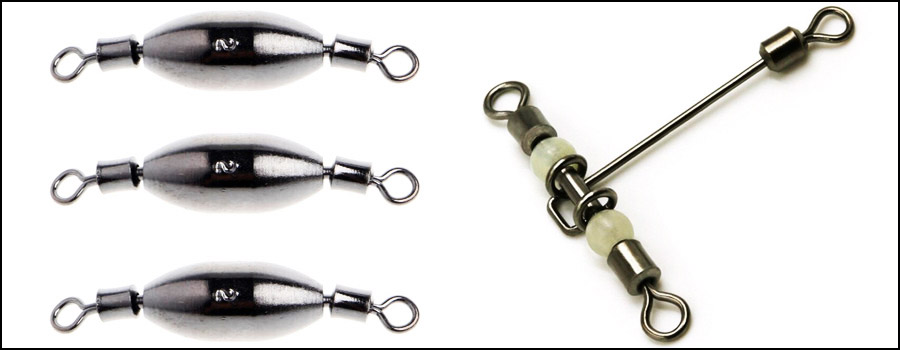
The size and strength of the swivel are crucial factors to consider. A swivel that is too small or weak may break under the pressure of a large fish, while a swivel that is too large may be too visible to the fish or affect the movement of your lure.
🟫 Size: The size of the swivel should match the size of your line and lure. A general rule of thumb is to use the smallest swivel that can handle the weight of your target fish.
🟫 Strength: The strength of the swivel is indicated by its pound-test rating. Make sure to choose a swivel with a pound-test rating that matches or exceeds the strength of your fishing line.
Tips for Matching Swivel with Line and Lure
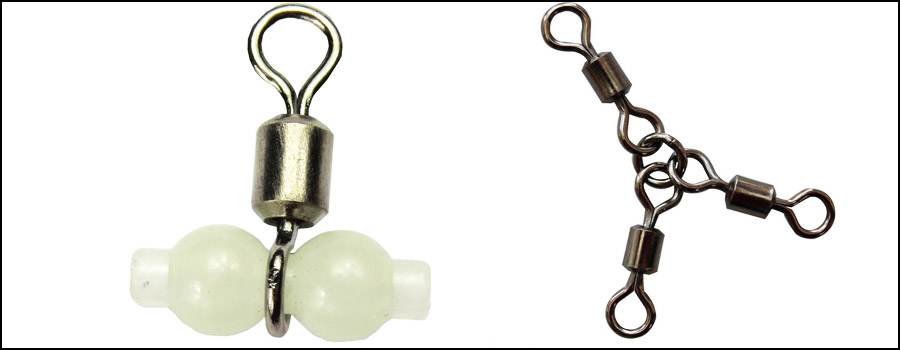
🟧 Line Size: Match the swivel size to your line size. For example, if you are using a 20-pound test line, use a swivel with a 20-pound test rating or higher.
🟧 Lure Weight: The weight of your lure will also affect your choice of swivel. Heavy lures may require a larger and stronger swivel to support their weight.
🟧 Visibility: In clear water, use a smaller and less visible swivel to avoid spooking the fish. In murky water or strong currents, visibility is less of a concern, and a larger swivel may be more appropriate.
🔶 Remember, the key to successful fishing is to adapt your gear to the conditions and the target species. By considering your fishing style, target species, water conditions, and matching your swivel to your line and lure, you can maximize your chances of success on the water. 🎣👍
Proper Usage and Maintenance of Swivels
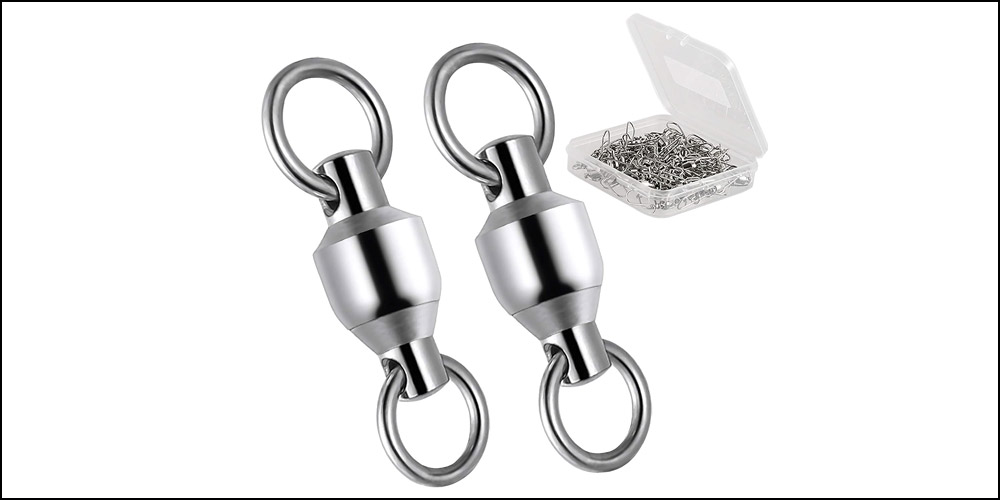
Swivels are an essential part of your fishing gear, and knowing how to use and maintain them properly is crucial for their effectiveness and longevity. Here is a guide on the proper usage and maintenance of swivels:
Step by Step Guide on How to Attach Swivels
🟡 Thread the Line: Start by threading your fishing line through one end of the swivel. If you are using a snap swivel, thread the line through the non-snap side.
🟡 Tie a Knot: Tie the line to the swivel using a strong and reliable knot. The improved clinch knot or the Palomar knot are popular choices for attaching swivels.
🟡 Attach the Lure or Hook: If you are using a regular swivel, tie your lure or hook to the other end of the swivel. If you are using a snap swivel, simply open the snap and attach your lure or hook.
Common Mistakes to Avoid While Using Swivels
🟢 Using the Wrong Size: Using a swivel that is too small or too large for your fishing line and lure can lead to failure. Make sure to match the swivel size with your line and lure weight.
🟢 Overloading the Swivel: Do not exceed the pound-test rating of the swivel. If the swivel is rated for 20 pounds, do not use it with a line or target fish that exceeds that weight.
🟢 Not Checking for Wear and Tear: Regularly check your swivels for signs of wear and tear. Damaged or worn-out swivels can fail unexpectedly.
Tips for Maintaining Swivels to Ensure Longevity
🟣 Regular Inspection: Regularly inspect your swivels for any signs of damage or wear and tear. Check for any rust, cracks, or bends in the swivel.
🟣 Clean After Use: After each fishing trip, make sure to clean your swivels thoroughly with fresh water to remove any salt, dirt, or debris.
🟣 Lubricate: Occasionally lubricate the moving parts of the swivel with a light reel oil to ensure smooth rotation.
🟣 Store Properly: Store your swivels in a dry and cool place to prevent rust and corrosion.
🔶 By following these steps for the proper usage and maintenance of swivels, you can ensure their effectiveness and longevity, ultimately leading to a more successful and enjoyable fishing experience. 🐟✨
How To Tie A Swivel On The Fishing Line?
| Knot Name | Step-by-Step Instructions | Best Used For |
|---|---|---|
| Improved Clinch Knot |
|
This is a very popular knot for attaching swivels, hooks, and lures. It is strong, reliable, and easy to tie. |
| Palomar Knot |
|
This knot is considered one of the strongest knots, and it works well with braided, monofilament, and fluorocarbon lines. It is excellent for attaching swivels, hooks, and lures. |
| Trilene Knot |
|
This knot is a strong and reliable knot for attaching swivels, hooks, and lures to monofilament and fluorocarbon lines. |
🔶 Remember, practice makes perfect, so be sure to practice tying these knots several times before you head out on your fishing adventure. Also, always wet the line before tightening the knots as this reduces friction and helps the knot to cinch down properly.
Importance of Properly Attaching Swivels to Fishing Line
Many newcomers to the fishing world are unaware of the correct method to attach a swivel to the fishing line, a mistake often made by seasoned anglers as well. Attaching a swivel correctly is crucial for a successful fishing experience. Incorrectly tied swivels can lead to lost fish, damaged gear, and a lot of frustration. Hence, it is essential to learn and practice the right techniques. To aid in this, consider viewing instructional videos that detail the correct way to tie swivels to your fishing line. These videos provide step-by-step guidance that can be invaluable for anglers of all experience levels. Remember, practice makes perfect!
Expert Tips for Using Swivels
Swivels are incredibly versatile and can be beneficial in various fishing situations. However, knowing when and how to use them effectively is key to maximizing their potential. Here are some expert tips on using swivels:
Situations Where Swivels are Most Beneficial
🧿 Trolling: When trolling, your bait or lure is constantly moving, which can cause the line to twist. Using a ball bearing swivel can prevent line twists and ensure your lure moves naturally in the water.
🧿 Using Spinning Lures: Spinning lures, such as spinners or spoons, can cause your line to twist as they rotate in the water. A swivel will absorb the rotation and prevent the line from twisting.
🧿 Bottom Fishing: When bottom fishing, a three-way swivel can be incredibly beneficial as it allows you to attach a weight, a hook, and your main line all at once, helping to present your bait at the desired depth.
Tips on Optimizing Swivel Performance
⚪ Match the Swivel to Your Gear: Make sure to match the swivel size and strength to your fishing line, lure, and target species. A swivel that is too small or too weak can fail under pressure, while a swivel that is too large can be too visible to the fish.
⚪ Use the Right Type of Swivel: Different fishing situations require different types of swivels. For example, use a ball bearing swivel for trolling or a snap swivel for quick lure changes.
⚪ Attach Swivels Properly: Make sure to attach the swivel properly to your line and lure. Use strong and reliable knots and check for any signs of wear and tear before and after each use.
When Not to Use a Swivel
🟤 In Clear Water: In clear water, fish can be more wary and may be spooked by the sight of a swivel. In such situations, it may be better to tie your lure or hook directly to your line.
🟤 When Using Light Lures: Light lures may not have enough weight to pull the line through the swivel, which can affect the lure’s action in the water. In such cases, it may be better to tie the lure directly to the line.
🟤 When Casting Long Distances: Swivels can affect the aerodynamics of your lure, making it more challenging to cast long distances. If long casts are essential, it may be better to tie your lure directly to your line.
🔶 Remember, while swivels can be incredibly beneficial in many fishing situations, there are times when it may be better not to use them. Consider the fishing conditions, your target species, and your fishing gear before deciding whether or not to use a swivel. 🎣👌
❓ FAQ About Fishing Swivels
In Conclusion
Swivels are a small but vital component of your fishing gear that can make a big difference in your fishing success. Understanding the different types of swivels, their specific uses, and how to choose, use, and maintain them properly can drastically enhance your fishing experience.
Throughout this article, we have discussed the importance of good quality equipment in fishing and introduced fishing swivels as an essential item in your fishing gear. We have explained what fishing swivels are, why you need them, how to choose the right swivel, and provided expert tips for using swivels effectively. Understanding the nuances of fishing swivels and their correct usage can drastically enhance your fishing experience.
Remember, what works best for one angler may not work best for another. It is essential to experiment with different types of swivels, sizes, and setups to find what works best for you, your gear, and the fishing conditions you encounter. Don’t be afraid to try new things and learn from your experiences.
Quality swivels are a worthy investment that can pay off in the long run by preventing line twists, making it easier to change lures, and helping to present your bait more effectively. Make sure to invest in quality swivels and practice proper usage and maintenance to maximize their effectiveness and longevity. Your fishing success may depend on it!
🔶 Thank you for reading, and here’s to successful and enjoyable fishing adventures! 🎣🥳
Tags: #best fishing swivels / #best fishing knot for swivels / #best swivels for fishing / #what are the best ball bearing swivels for fishing / #best ball bearing fishing swivels

I live in Tenerife (Canary Islands) for the last 10+ years and share my daily fishing experiences on my website. Many years of personal experience as a fisherman and the vast experience of my friends allow me to write professionally on any fishing topics (from choosing a flashlight and equipment to deep-sea fishing).
All of my advice is based on practical real-world experience and will be useful to both novice anglers and professionals. Read more about the author.
Affiliate Disclosure: FishReeler.org sometimes gets paid for listings, through sponsors or affiliate programs like Amazon, Ebay, Cabelas, Bass Pro Shop, Shimano, Daiwa, Rapala, Renn, Okuma, KastKing, etс. Clicking a link helps keep FishReeler.org free, at no extra cost to you!
About the author: Each article is verified by the fishing expert Sergio Smirnoff. The articles are written by professional and amateur fishermen with 20+ years of fishing experience.
Note: The views and opinions expressed in this article are those of the authors and do not necessarily reflect the official policy or position of any agency. The articles are for informational purposes only, share your opinions in the comments and join the fishing discussions, let's share our fishing experiences together!

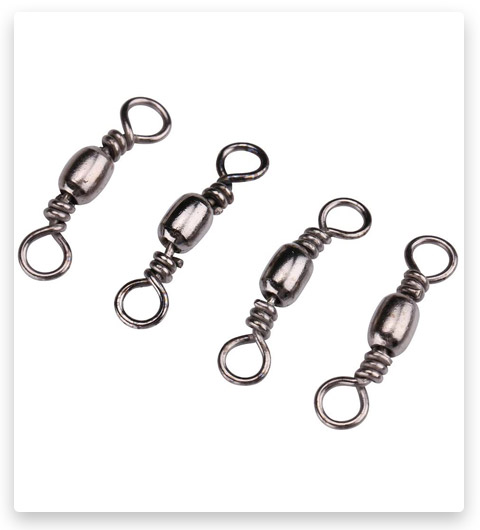
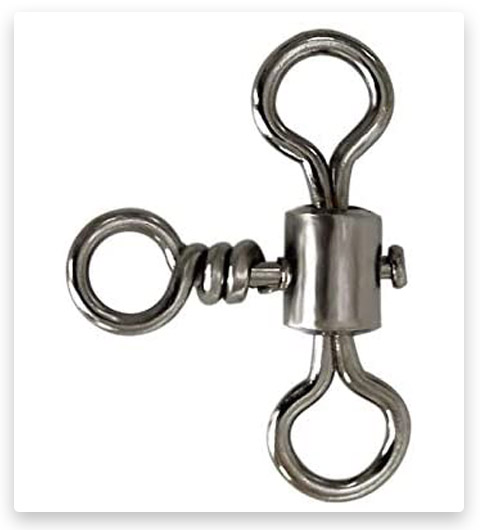
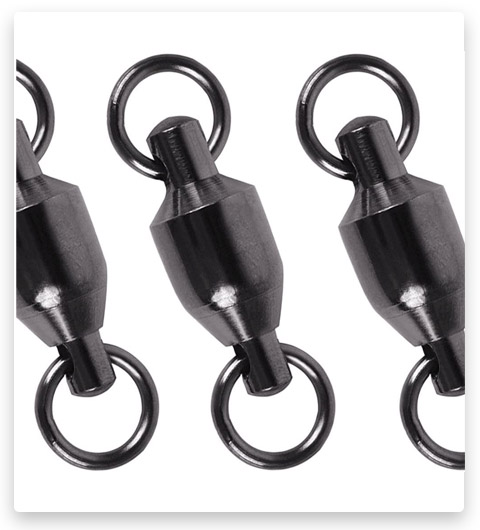


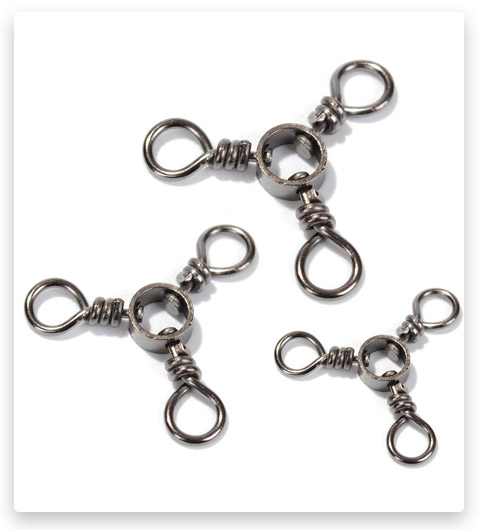
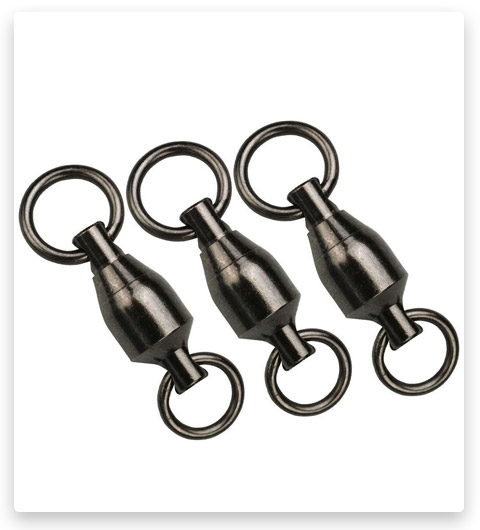
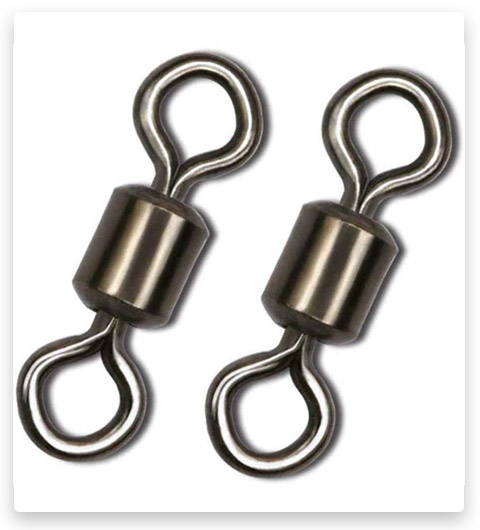
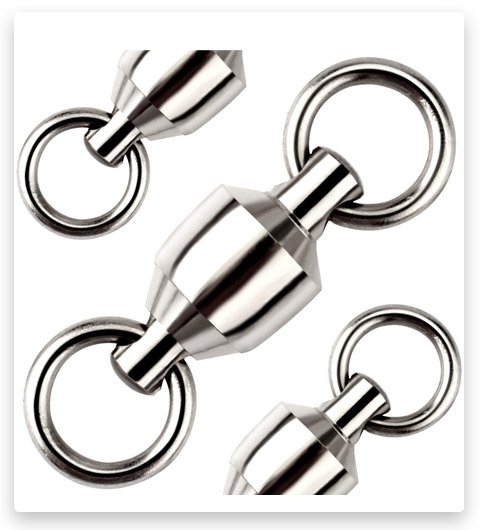


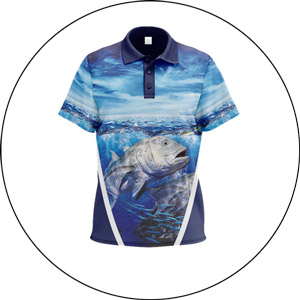
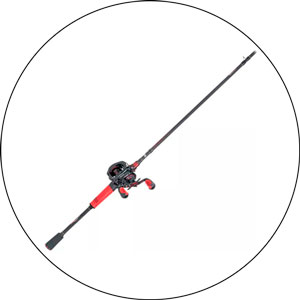
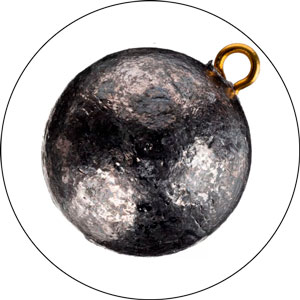
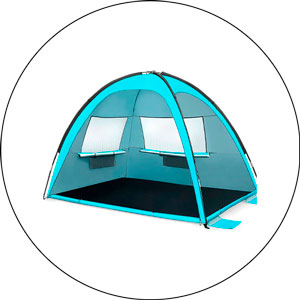

In my experience, I’ve found that different fishing hooks come in different sizes and materials, but ultimately serve the same purpose. Personally, I have used both silver and brass hooks from Eagle Claw and have had success with both.
If you’re looking to purchase some hooks for your next fishing trip, I recommend checking out your local Walmart as they usually carry a good selection in their fishing aisle. Tight lines and happy fishing!
Personally, I prefer using swivels attached directly with a small split ring to any spinning lure such as spoons or inline spinners. This technique has helped me reduce line twists and improve my overall fishing experience. However, I always opt for the smallest swivels and split rings I can find and never use snaps.
On the other hand, when it comes to other types of lures, I prefer not to use any additional hardware. Tying a leader may require some practice, but it is a skill that every angler should have. Connecting the line to the hook or lure is also relatively simple.
One of the main reasons I avoid using additional hardware is because it adds unwanted visibility to my setup. This can turn off wary fish and even serve as a target for actively feeding fish. In my experience, mackerel are notorious for hitting swivels and cutting the line.
In my personal experience, when it comes to using hard baits such as crankbaits and spinnerbaits, I tend to use a snap swivel. I’ve found that this doesn’t affect the action of the bait and makes changing them much easier without any significant downside. However, for plastics and small baits, I always tie direct to the line.
Living in pike territory, I’ve discovered that using a swivel and snap acts as a short leader on the most vulnerable part of my line. This has helped me avoid losing lures to those toothy critters that tend to frequent these waters. It’s a great way to add some extra protection to my gear when fishing in areas where I wouldn’t normally use a leader.
In summary, using a snap swivel for hard baits can be a game-changer, making it easier to switch out lures and maintain a consistent action. And when fishing in areas where toothy fish are common, using a swivel and snap can help protect your gear and save you from losing expensive lures.
I used to be a fan of snap swivels as they allowed me to switch out lures quickly. However, I’ve since changed my approach and now prefer direct tying for a few reasons.
Firstly, tying directly forces me to stick with a lure for longer periods of time, rather than constantly changing. This has helped me become more patient and strategic in my approach.
Secondly, direct tying eliminates weak points in the setup, reducing the chances of breakage during a fight. This gives me added confidence when reeling in big fish.
Lastly, direct tying preserves the intended performance and appearance of the lure, which can be crucial when trying to attract fish. Using a swivel can alter the natural movement of the bait and potentially scare away fish.
I stopped using swivels in still water years ago and have noticed an improvement in my catch rates since making the switch. It’s important to remember that we’re trying to mimic the fish’s natural food source, and that little leach would be swimming forward without spinning in circles, which a swivel might cause.
In conclusion, while snap swivels can be convenient, direct tying can offer several benefits, including increased patience, reduced weak points, and more natural lure movement. It’s worth giving direct tying a try and seeing if it makes a difference in your fishing success.
I wanted to share my thoughts on the use of swivels in fishing, particularly when it comes to the Ned Rig. In my opinion, swivels are generally used to prevent line twists or to act as a stopper for a bubble float or a Carolina rig. However, there is no good reason to have one on a Ned Rig, which is one of the most finesse rigs out there.
Using a swivel on a Ned Rig can actually hurt your catch rates and increase the chances of failure. It’s an unnecessary point of failure that can get fouled up and snagged, potentially ruining your fishing experience. Tying knots is just part of fishing, and it’s a skill that every angler should develop.
Ultimately, the goal of fishing is to make the most natural presentation possible to the fish. Adding a swivel to a Ned Rig can compromise the natural action of the bait, which can be detrimental to your success. So, unless you have a specific reason for using a swivel on a Ned Rig, it’s best to skip it and tie it directly to the line.
In summary, swivels have their place in fishing, but using them on a finesse rig like the Ned Rig is unnecessary and can do more harm than good. It’s always best to focus on making the most natural presentation possible to increase your chances of success.
I wanted to share my thoughts on the use of swivels in fishing. While they serve a purpose, they can also reduce the authenticity of what you’re presenting to the fish. Swivels can affect the way a bait is designed to move and act, which can be a big problem if you’re going for a more finesse approach with hooks or jigs.
However, there are certain situations where swivels, dual locks, and other hardware can be useful. For example, when you’re searching for fish and need to quickly change lures, swivels can make that process much easier. I generally use them to swap between faster-moving lures like crankbaits, jointed cranks, topwater, buzzbaits, and jerkbaits. These types of lures are already moving quickly through the water, making the swivel less noticeable to fish.
That being said, I would never use a swivel on a hook or jig as it can compromise the finesse approach that those techniques require. It’s important to remember that sometimes the most subtle changes can be the difference between a bite and nothing, and using a swivel when it’s not needed can definitely hurt your chances of success.
So, is the swivel the reason why you didn’t catch any fish while your buddy did? It’s certainly possible, but there could also be other factors at play like technique, presentation, or simply being in the right place at the right time. It’s always best to experiment with different techniques and gear to see what works best for you in any given situation.
In conclusion, while swivels have their place in fishing, it’s important to use them wisely and not rely on them as a crutch. Always focus on making the most natural presentation possible to increase your chances of success.
The use of swivels depends on the type of lure you are using. For Rapala-style crankbaits, I avoid using swivels as they can cause the bait to spin. Instead, I prefer tying a Rapala knot or Fishman’s knot to the split ring.
Spoons are a different story. They have a tendency to twist your line, so a swivel is a must-have. When using single hooks, you want the hook point to face inward so it doesn’t snag when the spoon spins.
Inline spinners usually have a clevis, which means only the blade and the clevis spin, not the body of the spinner. Therefore, you may not need a swivel, but I sometimes add one when building my own spinner. In such cases, I tie directly onto the swivel that’s already included.
For jigs, I never use swivels. Swivels are mainly required for lures that will spin and twist your line. That’s why you don’t see many people using swivels for lures other than spoons and some inline spinners. In conclusion, the use of swivels is a matter of personal preference and depends on the lure you are using.
Using snap swivels has been a huge time saver when it comes to changing out lures and trying to figure out what’s working for the fish. It’s especially helpful when I’m using artificial lures and trying to narrow down what’s getting results. Plus, constantly cutting and retying my line can result in a loss of leader material over time.
I do understand the concern about using a swivel potentially discouraging bites, especially when using a soft plastic that looks very realistic. However, I think it really depends on the lure. If I’m using a bright and flashy spoon or a colorful chatter bait, I don’t think a small swivel is going to have a negative visual effect. That being said, I have noticed that using a swivel can slightly affect the action of some lures.
Overall, I think snap swivels are a great tool to have in your tackle box, especially for quickly changing out lures and experimenting with different setups. But it’s important to consider the impact they may have on the presentation and action of your lure and to adjust accordingly.
I tend to avoid using snap swivels due to their bulkiness, but I do find myself using snaps and swivels separately quite often. When it comes to an inline spinner while trout fishing, I typically put the swivel further up the line between the mainline and the leader and then tie the snap on at the very end of the setup calls for both a snap and a swivel.
For snaps, I prefer duo snaps as they appear to be lighter than comparably sized TA snaps, but that’s just my first impression comparing them with the naked eye. I have never experienced a failure with duo snaps, so I have never felt the need to experiment with any other type of snap.
I don’t usually use snaps on setups like wacky rigs or ned rigs, but I have used them before and they seem to work just fine. However, I always use snaps on lures as their action is better on a snap than on a tied knot, and I’ll also use them on jigs and swim baits. The only things I never use snaps on are Texas rigs and topwater frogs.
To be honest, I’m just lazy and don’t want to waste the leader line by constantly re-tying knots when swapping out baits. But that’s just me!
When targeting channel catfish in the 3-10 lbs range, I recently invested in some Team Catfish double action circle hooks. Now, I’m on the hunt for a reliable barrel swivel for my Carolina Rig. However, I’ve come across some comments from people who have experienced their swivels breaking, which has left me unsure about which one to choose. I’d appreciate any advice or recommendations for a good-quality swivel.
I’ve come across various types of fishing swivels that cater to different fishing needs. Here are some of the most popular models I’ve seen and used:
Ultimately, the best fishing swivel will depend on your specific fishing needs and preferences. However, with so many great options available, you’re sure to find a swivel that works for you.